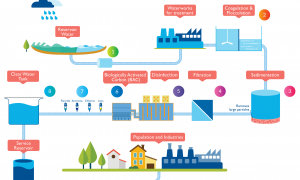🕑 Reading time: 1 minute
Irrigation is defined as the science of artificially providing water to the land in accordance with the "crop requirement" throughout the "crop period" for the complete nourishment of the plant.
The main types of irrigation are briefly explained in this article.
Types of Irrigation
Irrigation can be broadly divided into two main types, namely:
- Surface Irrigation
- Sub-surface Irrigation
1. Surface Irrigation
Surface irrigation is again divided into Flow Irrigation and Lift irrigation.
Flow Irrigation
In this type of irrigation, the water available at higher levels is allowed to move to the crops present in the lower level by the action of gravity. Flow irrigation is again classified into:
- Perennial Irrigation
- Flood Irrigation
1. Perennial Irrigation
This irrigation system guarantees continuous and constant water supply to the crops throughout the crop period as per the requirement of the crop. This system supply water to the crops through a canal distribution system that takes off from a weir or a reservoir.
If the irrigation water is taken by diverting the river runoff to the main canal by the construction of a diversion weir, then this irrigation is called as direct irrigation. If a dam is constructed across the river and the stored water is used to perform irrigation, then it is called storage irrigation.
Direct irrigation is the simplest and most economical perennial irrigation. The perennial irrigation is also called as Controlled Irrigation.
2. Flood Irrigation
Flood irrigation also called inundation irrigation is an irrigation method that intentionally creates a flooded land condition. This makes the soil completely saturated. After this, occasional natural rainfall is sufficient for the maturity of the crops.

This irrigation method is best suitable for lands where there is a river nearby with a higher water level and a controlled flow of water to the land is not possible. So, the water is allowed to flow in surplus until a flooded condition is reached. Hence this irrigation is an uncontrolled irrigation system.
Lift Irrigation
In this type of irrigation, the water is lifted with the help of a mechanical or manual arrangement like pumps, etc. Using the water from wells and tube wells to water the crops at higher levels are examples of lift irrigation.
2. Sub-Surface Irrigation System
In the case of the sub-surface irrigation system, the soil surface is not made wet. Instead, the water sufficient for the crops is provided by means of underground water by the action of capillarity.

Sub-surface irrigation can be performed either naturally or artificially.
Natural Sub-Surface Irrigation
There are possibilities of water leakage from the water channels or pipes. The water moves through the subsoil and may irrigate the crops nearby. This water leakage may also increase the water level of underground water which also helps to nourish the crops.
This way, when underground irrigation is achieved without any additional effort, it is defined as natural sub-surface irrigation.
Artificial Sub-Surface Irrigation System
In the artificial sub-irrigation system, artificial water channels are provided in the underground and water is supplied to the crops under the action of capillarity. This irrigation type is very costly and employed for crops that provide high returns and profit.
In certain areas, small ditches are made in different locations of the irrigation land, so that water from the ditches may percolate and nourish the crops, which also is a method of sub-surface irrigation system.
Also Read: Surveying for Irrigation Projects


